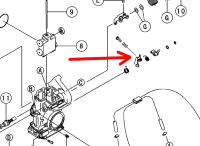I did.
Here is my understanding -
Smaller bikes dont use an AP because of the small diameter of the venturi. The smaller the opening, the higher velocity the air must travel through it, and that high velocity is enough to suck the fuel up the pipe (jet passage). Coincidentally, this is also why there is always congestion in traffic when there is a merge in traffic, people need to speed the F up, but I digress...
The bigger bikes venturis are larger and so the velocity is not there at start-up, so they use pussy pump to give a squirt of fuel until the rev's come up enough to have the added air velocity start using the jet system.
The reason the wire was there (many people use a lubed o-ring) was to combat the "lean bog" that happens when you quickly crack the throttle open; the throttle valve goes up quickly, the pressure in the venturi drops, but the air velocity needs a second to come up as BPM's rise, and the system goes lean. This is where the chick comes in again, it gives an added blast of fuel to keep the system from going lean, until the BPMS come up enough to start using the jet system again.
In my case, the chicks arm was being held in a half-open, half-closed state, and not allowing any fuel to be squirted, especially at start up.
If too much fuel is squirted, you get a rich condition, and this is where the leak jet comes in. The leak jet determines how much fuel goes into the squirt, by leaking a smaller or larger portion of the squirt back into the float bowl. The smaller the leak jet, the larger the squirt, and vice-versa. A leak jet is like a faucet in your house. You stand at the kitchen sink and run the woman and it comes out full blast; until your kid flushes the toilet, or uses the shower, or another faucet (leak jet) gets turned on, and the pressure at the sink drops. Same concept.
Yesterday was an awesome learning day for me, and I expect to have this thing running before noon. I might even take it to the track with me on Saturday before we go to Supercross

.



 .
. M-39404
M-39404
 . Replaced the shift shaft and lever only to find that the kick starter wouldn't return, just like my 250, took it apart to find that its broken...might just bring a rope to the track, lol!
. Replaced the shift shaft and lever only to find that the kick starter wouldn't return, just like my 250, took it apart to find that its broken...might just bring a rope to the track, lol! Hi
Hi 

